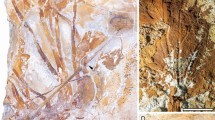Abstract
Subtype PIII sieve-element plastids, anthocyanins, spinulose, perforate-tectate pollen grains and the specific seed-coat sculpturing found in twoMacarthuria species (M. australis, M. neocambrica) consolidate their placement withinMolluginaceae. The unique form of the sieve-element plastids, i.e. with cubic crystals and starch grains (PIIIc″fs), finds its closest counter-part inLimeum. The multiple intertwinement of different genera of theMolluginaceae with many other centrospermous families led to a consideration of their more central position withinCaryophyllales.
Similar content being viewed by others
References
Barthlott, W., 1983: Microstructural features of seed surfaces. — In:Heywood, V. H., Moore, D. M., (Eds.): Current Topics in Plant Taxonomy. — Academic Press (in print).
Beck, E., Merxmüller, H., Wagner, H., 1962: Über die Art der Anthocyane beiPlumbaginaceen, Alsinoideen undMolluginaceen. — Planta58, 220–224.
Behnke, H.-D., 1976a: Die Siebelement-Plastiden derCaryophyllaceae, eine weitere spezifische Form der P-Typ-Plastiden bei Centrospermen. — Bot. Jahrb. Syst.95, 327–333.
—, 1976b: Ultrastructure of sieve-element plastids inCaryophyllales (Centrospermae), evidence for the delimitation and classification of the order. — Pl. Syst. Evol.126, 31–54.
—, 1977: Transmission electron microscopy and systematics of flowering plants. — Pl. Syst. Evol., Suppl.1, 155–178.
—, 1981: Sieve-element characters. — Nordic J. Bot.1, 381–400.
—, 1982a: Sieve-element plastids, exine sculpturing and the systematic affinities of theBuxaceae. — Pl. Syst. Evol.139, 257–266.
—, 1982b:Geoarpon minimum: Sieve-element plastids as additional evidence for its inclusion in theCaryophyllaceae. — Taxon31, 45–47.
—, 1982: New evidence from the ultrastructural and micromorphological fields in angiosperm classification. — Nordic J. Bot.3, 43–66.
Behnke, H.-D., Pop, L., Sivarajan, V. V., 1983: Sieve-element plastids ofCaryophyllales: Additional investigations with special reference to theCaryophyllaceae andMolluginaceae. — Pl. Syst. Evol.142, 109–115.
Cronquist, A., 1981: An Integrated System of Classification of Flowering Plants. — New York: Columbia Univ. Press.
Dahlgren, R. M. T., 1980: A revised system of classification of the angiosperms. — Bot. J. Linn. Soc.80, 91–124.
Ehrendorfer, F., 1976: Closing remarks: systematics and evolution of centrospermous families. — Pl. Syst. Evol.126, 99–105.
Hutchinson, J., 1926: The Families of Flowering Plants1. — London: McMillan.
Hofmann, U., 1973: Morphologische Untersuchungen zur Umgrenzung und Gliederung der Aizoaceen. — Bot. Jahrb. Syst.93, 247–324.
Leuenberger, B. E., 1976: Die Pollenmorphologie derCactaceae und ihre Bedeutung für die Systematik. — Diss. Botanicae31, 321 pp. — Vaduz: J. Cramer.
Mabry, T. J., 1976: Pigment dichotomy and DNA-RNA hybridization data from centrospermous families. — Pl. Syst. Evol.126, 79–94.
—, 1977: The orderCentrospermae. — Ann. Miss. Bot. Gard.64, 210–220.
-Behnke, H.-D., (Eds.), 1976: Evolution of Centrospermous Families. — Pl. Syst. Evol.126 (1).
—, 1976: Betalains and P-type sieve-element plastids inGisekia L. (Centrospermae). — Taxon25, 112–114.
—, 1975:Theligonaceae: Pigment and ultrastructural evidence which exclude it from the orderCentrospermae. — Biochem. Syst. and Ecol.3, 53–55.
—, 1970: The Systematic Identification of Flavonoids. — Heidelberg: Springer-Verlag.
Moquin-Tandon, A., 1849:Phytolaccaceae. — In:A. DeCandolle: Prodromus systematis naturalis regni vegetabilis13, pt. 2, pp. 2–40. — Paris: Masson.
Nowicke, J. W., 1975: Pollen morphology in the orderCentrospermae. — Grana15, 51–77.
-Skvarla, J. J., 1977: Pollen morphology and the relationships of thePlumbaginaceae, Polygonaceae, andPrimulaceae to the orderCentrospermae. — Smithsonian Contributions to Botany37, 64 pp.
—, 1979: Pollen morphology: the potential influence in higher order systematics. — Ann. Miss. Bot. Gard.66, 633–700.
Richardson, P. M., 1981: Flavonoids of some controversial members of theCaryophyllales (Centrospermae). — Pl. Syst. Evol.137, 227–233.
Skvarla, J. J., Nowicke, J. W., 1976: Ultrastructure of pollen exine in the centrospermous families. — Pl. Syst. Evol.126, 55–78.
Takhtajan, A., 1980: Outline of the classification of flowering plants (Magnoliophyta). — Bot. Rev.46, 225–359.
Thorne, R. F., 1976: A phylogenetic classification of theAngiospermae. — Evol. Biol.9, 35–106.
Voit, G., 1979: Untersuchungen zur Mikromorphologie derCactaceen-Samen unter Berücksichtigung taxonomischer Aspekte. — Dissertation Heidelberg.
Author information
Authors and Affiliations
Rights and permissions
About this article
Cite this article
Behnke, H.D., Mabry, T.J., Neumann, P. et al. Ultrastructural, micromorphological and phytochemical evidence for a “Central Position” ofMacarthuria (Molluginaceae) within theCaryophyllales . Pl Syst Evol 143, 151–161 (1983). https://doi.org/10.1007/BF00984117
Received:
Issue Date:
DOI: https://doi.org/10.1007/BF00984117




